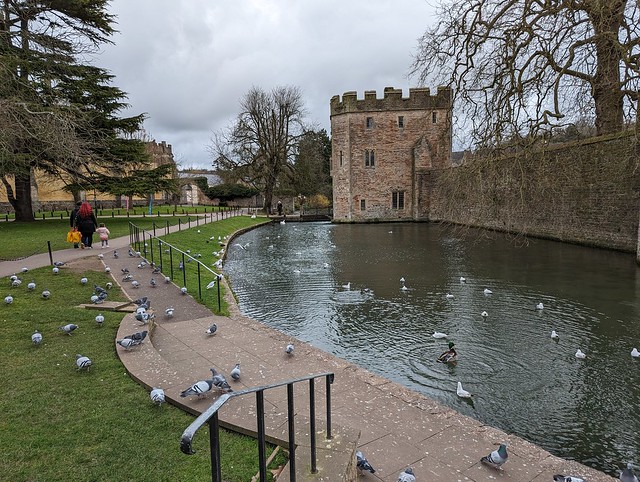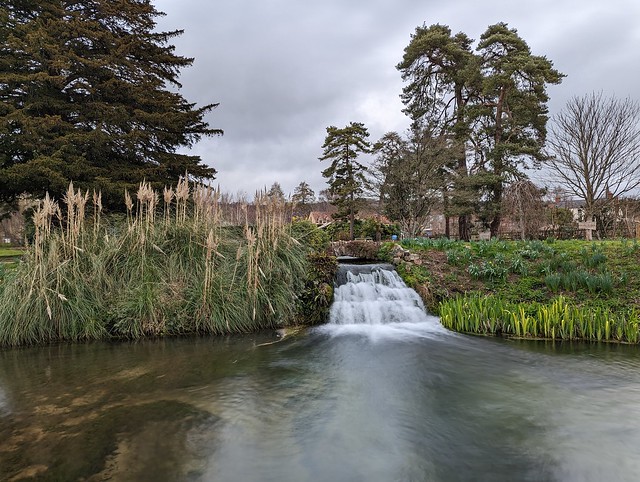March 6th 2023
Somewhere in a box I have a print of a photo of Wells Cathedral taken on a Kodak Instamatic camera. I reckon it was taken some time in the late 1980s or early 1990s on a fleeting visit to the city and until now I’d not been back to England’s smallest city. So as spring approached I planned a slightly longer visit which inevitably triggered a weather warning for rain and snow because England.
The Cathedral
Wells Cathedral West front looks now much as I remember from the last time.
You don’t get to enter through that door though but through a separate entrance to the right via the gift shop (of course) and reception where you can be relieved of your donation on entry (strongly suggested to be £8). You can then wander about the interior and with a few restrictions take photos. Or if you time it right take a free guided tour which lasts about an hour. Which is what I did as I’d arrived at 1055 and the tour started on the hour. I’d recommend taking the guided tour, you’ll learn a lot more.
The cathedral was built from around 1175 to replace an earlier church on the site since 705. They built from East to West in a wholly Gothic style and you can see (when it’s pointed out to you) how the quality of the decorative carving improves as the masons gained experience. As the cathedral was put into use before the building was complete the Saxon font from the previous church which lay slightly to the north was moved to a temporary location in the new cathedral. It’s still in it’s temporary location some 800 or more years later.
There are many notable features of the cathedral so to pick a couple of biggies:
The Jesse Window at is one of the best examples of 14th century stained glass in Europe. It dates from about 1340 and, considering its age, is still remarkably intact, having narrowly escaped being destroyed during the Civil Wars and so today is basically how medieval glaziers designed and created it and how it looked when it was made. It is particularly large and the colours are still vivid.
The cathedral clock also dates originally to the 14th century although the mechanism has been replaced in the 17th century. There is a dial on the outside wall which was behind scaffolding on my visit. The more interesting face of the clock is inside in the North transept though. The dial represents the geocentric view of the universe, with Sun and Moon revolving round a central fixed Earth. Wikipedia describes it thus: The dial proposes a model of the universe. Against a background of stars, the Sun (the large gilded star on the outer ring) moves in a circle, and indicates the time using the 24-hour analogue dial, which is marked in Roman numerals from I to XII, then from I to XII again. Noon is at the top of the dial reflecting the position of the Sun in the sky at this time.
In the corners, four angels hold the four cardinal winds. These may be generating the power that makes the universe operate.
The minutes are indicated by a smaller star on the ring inside.
The inner circle shows the moon. A pointer indicates the age of the moon, between 1 and 30 days. The black and white disk above the centre shows the moon's phase. The white disk rotates once in a synodic month. The inscription around the moon phase indicator says sphericus archetypum globus hic monstrat microcosmum, which translates as This spherical globe here shows the archetypal microcosm. Howgrave-Graham suggests that the scribe erroneously put microcosmum, when macrocosmum is the more obvious word. Opposite the Moon circle is a weighted pivoted disc, containing a small painting of Phoebe, representing the Moon.[2] The inscription reads: Sic peragrat Phobe, or So progresses Phoebe.
At the centre of the dial, the ball represents the Earth, and the clouds suggest the same.
Above the clock and to the right is a figure, known as Jack Blandifers, or Blandiver, who hits a bell with a hammer held in his right hand and two bells hung beneath him with his heels. A set of jousting knights also chase each other every 15 minutes.
In the corners, four angels hold the four cardinal winds. These may be generating the power that makes the universe operate.
The minutes are indicated by a smaller star on the ring inside.
The inner circle shows the moon. A pointer indicates the age of the moon, between 1 and 30 days. The black and white disk above the centre shows the moon's phase. The white disk rotates once in a synodic month. The inscription around the moon phase indicator says sphericus archetypum globus hic monstrat microcosmum, which translates as This spherical globe here shows the archetypal microcosm. Howgrave-Graham suggests that the scribe erroneously put microcosmum, when macrocosmum is the more obvious word. Opposite the Moon circle is a weighted pivoted disc, containing a small painting of Phoebe, representing the Moon.[2] The inscription reads: Sic peragrat Phobe, or So progresses Phoebe.
At the centre of the dial, the ball represents the Earth, and the clouds suggest the same.
Above the clock and to the right is a figure, known as Jack Blandifers, or Blandiver, who hits a bell with a hammer held in his right hand and two bells hung beneath him with his heels. A set of jousting knights also chase each other every 15 minutes.
And the same poor bugger gets knocked off his horse each time :-)
The Bishop’s Palace
Having ‘done’ the cathedral I went for one of Costa’s finest flat whites and watched Wells’ finest dog-on-a-string-and-can-of-stella club in the market place and mooched over to the Bishop’s Palace where in exchange for sixteen of your finest UK pounds I got to explore a virtually deserted tourist attraction. I’d be surprised if there were more than half a dozen visitors in there. I’ll bet it’s not like that in the summer.
Located next to the cathedral the medieval palace and grounds date from the early-thirteenth century when Bishop Jocelin received a crown licence to build a residence and deer park on land to the south of the Cathedral. Entering from the market place via the gateway known as the Bishop's Eye you are confronted with a moat, gatehouse with drawbridge and ramparts topped with crenellations because being a bishop is as much about power, wealth, and authority as more spiritual matters. Also protecting yourself from the plebs.
800 years of successive and successful bishops have left their mark, adding bits to the palace and knocking other bits down, notably the former Great Hall built in the 1280s of which now only two walls remain, albeit impressive walls.
The interior rooms of the palace that are open to the public (the palace is still the bishop’s ‘office’) form a museum detailing the palace’s history. The long gallery has portraits of the majority of the bishops who have held the office.
Outside the palace gardens are a pleasant enough place to walk around and you can get some good views from a section of the ramparts. Allegedly you can see Glastonbury Tor. I couldn’t. The flowing wells or springs from which Wells gets its name are located in the palace grounds and water is channeled through streams and a waterfall into the moat.
The Bishop’s Palace is definitely worth a visit if you’re in Wells and on a fine day the gardens are probably a nice place to linger. In terms of bang-for-buck though I think the cathedral edges it.







